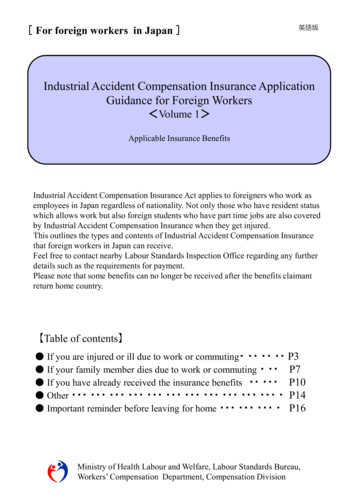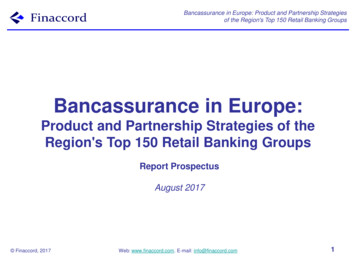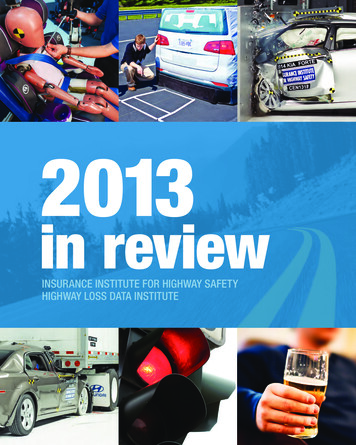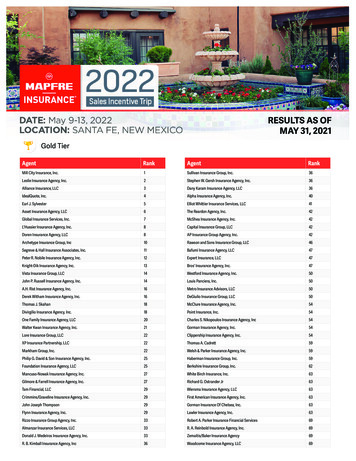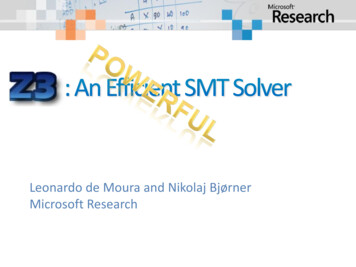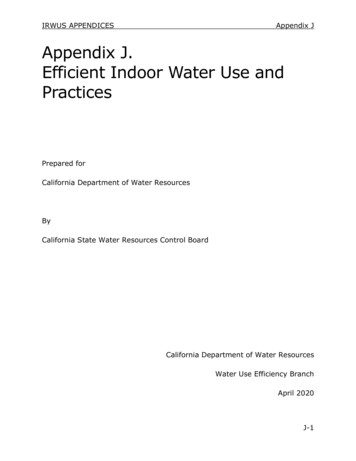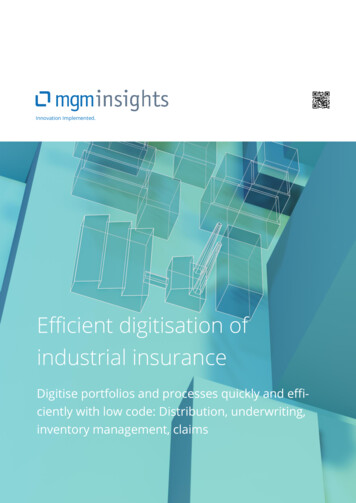
Transcription
Innovation Implemented.Efficient digitisation ofindustrial insuranceDigitise portfolios and processes quickly and efficiently with low code: Distribution, underwriting,inventory management, claims
ImprintAuthor: Alexander Stoltemgm technology partners GmbHFrankfurter Ring 105a80807 MunichPhone 49 89 / 358 680-0Place of jurisdiction and performance: MunichAll rights reserved. Reprint, alsoin extracts, only with permission. 2020 mgm technology partners GmbHwww.mgm-tp.com
ContentContent1.Introduction 42.Low code development as a solution for industrial insurers and brokers 53.Digitise industrial insurance more efficiently - with low code 84.Basics for the introduction 115.Example: Low code development with mgm A12 and Cosmo 136.Conclusion 167.References 178.Contact 18Efficient digitisation of industrial insurance mgm 20203
Introduction1. IntroductionMany industrial insurers are facing major challenges: "There is no easing of the marketsituation in sight. Even though the earnings situation of insurers improved last year, thepressure to implement portfolio improvement measures will continue". 1 In addition,many insurers are having problems covering their costs with premiums: "Even thoughthe GDV's projection2 for 2019 predicts a combined ratio of 98% and thus represents animprovement in results, not all insurers are profitable". 3There are several reasons for the tense earnings situation, three of which are important: Complex, paper-based processes from the "old days" that slow down communicationand data exchange between customers, brokers and insurers - especially in the areaof risk assessment and evaluation. IT systems that are difficult to adapt and lack technical standards. "It is "incomprehensible and unacceptable", according to the head of the General Association of theInsurance Industry (GVNW) Alexander Mahnke, "that on the part of industrial insurers, common standards for technical communication have still not been established.4 Lack of ideas on how products and processes can be translated into the 21st century.Although digitisation could optimise processes and reduce costs, many industrial insurers are hesitant: "Nevertheless, more than 40% of insurers have not implementedany digitisation initiatives in 2019, or have done so only insufficiently from their pointof view, and are thus giving away a lot of potential with regard to new business models, distribution channels or ways of working". 5Digitisation is therefore urgently needed in the industry. The levers for future businesssuccess are efficiency in internal administrative processes and improved risk selection.These should be introduced and implemented in the 21st century on the basis of a digitalend-to-end value chain. Companies therefore need a platform with which they canquickly create digital applications and insurance products.Low Code Development offers a suitable solution for this. With such a development platform, even non-developers (so-called Citizen Developers) in the business departmentsare able to put together products, processes and user interfaces. Since no new programcode is written, the error rate during digitisation is reduced - quality and speed are improved.1Willis Towers Watson: industrial insurance.General Association of the German Insurance Industry3Willis Towers Watson: industrial insurance4Kaspar, Alexander: Industrial insurance faces multipolar challenges.5EY Innovalue: More than 40% of insurers give away opportunities through digitisation initiatives2Efficient digitisation of industrial insurance mgm 20204
IntroductionIn an end-to-end digitalised world, underwriters can focus on the truly complex processesand challenges and brokers can invest more time in the advice that is important for a customised offer. Insurers, brokers and clients benefit equally.Detailed information on Low Code and the possible applicationsCrisp-Research-Study in cooperation with mgm: Low Code Development - Recommendations for planning and deployment.At: https://a12.mgm-tp.com/index en.html#insightsEfficient digitisation of industrial insurance mgm 20205
Low code development as a solution for industrial insurers and brokers2. Low code development as asolution for industrial insurersand brokersIn many companies and across many industries, business and IT decision-makers are discussing the use of low code to accelerate application development time. This is becausethe concept brings - among other detailed changes - the abandonment of classic, usuallytime-consuming software development processes and the strict separation between thespecialist department and development.But what is Low Code actually? Put simply, low code applications are development platforms that use visually supported development tools and graphic modelling methods instead of written code. This means: By means of a graphical user interface, the users (Citizen Developer) can put together correspondingly prefabricated modules and elements asthey need them. This applies not only to the initial digitalisation in a company, but alsoand above all to changes and updates to risk issues, dependencies and coverage models,as well as to completely new product ideas. Instead of going a long way through the ITdevelopment, a trained employee can model these cases and implement them completely or in large parts on his or her own. Moreover, applications and modules that havealready been programmed and are used again and again do not have to be developedanew each time.Example Use Case:An industrial insurer wants to launch a new insurance product. The starting point is usually a risk questionnaire and a data model derived from it. Thanks to low code and an existing set of data models, a implementation-ready first version of the digitalised productcan be developed quickly. With this fail-fast method, insurers can immediately seewhether the idea is viable and whether a particular product is worthwhile for them. If theidea is less promising, costs are kept within reasonable limits - the ideal solution for making underwriting processes more efficient. In addition, a new product is directly part ofthe internal processes if it is developed on an integrated low-code platform.How successful low code can be in the future was analyzed by the consulting firm Gartner: "By 2024, three-quarters of large enterprises will be using at least four low-code development tools for both IT application development and citizen development initiatives.By 2024, low-code application development will be responsible for more than 65 % of application development activity." 66Gartner: Magic Quadrant for Enterprise Low Code Application Platforms.Efficient digitisation of industrial insurance mgm 20206
Low code development as a solution for industrial insurers and brokersThe advantages of Low Code: get faster to the final application less programming effort more flexibility in applications and insurance products Cost savings in programming and work processes Low-code users can be quickly trained no technical difference between "prototype" and implementation-ready software Applications can be changed flexibly at any timeLow Code is not equal to Low CodeAlthough many low-code platforms can map simple processes, they fail due to complexapplications and their integration into heterogeneous IT landscapes. For this reason, custom development is often necessary, for example to program interfaces and to connectsystems with each other. Especially in the enterprise this means: Low code and classiccode must grow together in order to realise complex applications quickly and securely.On the left, the classic role distribution is shown, on the right therole distribution of the modelbased approach. In addition tothe developer, the business analyst independently helps to designparts of the application.Efficient digitisation of industrial insurance mgm 20207
Digitise industrial insurance more efficiently - with low code3. Digitise industrial insurancemore efficiently - with lowcodeWhat would happen if underwriters or brokers no longer exchanged data manually by email and telephone, but instead communicated digitally end-to-end - with the help of selfdesigned digital products and processes? The role of underwriters and brokers wouldchange fundamentally - they would directly implement the market requirements of theirpartners and customers in digital form and actively participate in shaping digitalisation.Even if these promises still sound like dreams of the future, they can already be realisedto a large extent today. Only the first step needs to be taken.From clauses and conditions to a technical product frameworkIndustrial insurance products consist of various components such as coverage model,risk questionnaire, tariff and premium model as well as various documents (offer, policy,terms and conditions, etc.). In general, the task is to identify and analyse the core components of each product and to bring them together in a technical product framework. Indetail, a digital product includes a corresponding data model, but also the meaningful order of fields in online forms. Important in this context is always a look at the needs ofbrokers, insurers and customers.So digitisation means above all the structuring of the components: Products and processes that are traditionally handled rather individually must be translated into structures and regulations - including a clearly defined individual degree of flexibility, which isabsolutely essential especially in the industrial insurance sector.These standards are crucial for the automated execution of processes. There must becertain rules according to which the system makes content and process decisions. Example: If the equity ratio of a D&O insurance policy is too low, many insurers automaticallysuspend insolvency above a certain limit. It is precisely such clearly defined limits, abovewhich a clause is automatically added, that can be very well mapped in the IT systems.Important despite standardisation: individual flexibilityFor standardisation, the implementers in project teams must ask themselves not only therelevant individual questions, but also questions about the rules. Experts at insurers andbrokers have a wealth of experience accumulated over years and decades and a comprehensive knowledge of all conceivable insurance cases. This knowledge needs to be transferred into structures that can be mapped in software. A good starting point, for example, is to look at parallels between cases and to define boundaries.Efficient digitisation of industrial insurance mgm 20208
Digitise industrial insurance more efficiently - with low codeFor the industrial and commercial insurance sector, the process requires a complex rethinking process. Previously, underwriters looked at each case individually and assessedrisks manually through experience and with gut feeling. Therefore, the business expertsshould be significantly involved in the entire digitisation process. On the side of insurers,it should also be clear where the sales partners deliberately leave room for customerspecific risk situations.An important requirement is also to be able to produce the products in a reasonabletime frame. Six months and more is not an option. A new product should take a maximum of two to three months and a variant of the product, for example for a sales partner, no longer than a few days or weeks. This is possible with a consistently implementedplatform model: from simple products and local coverages to multinational solutions. Inaddition, there is a higher product quality, real-time services and the possibility to quicklyenter new business models.The difference is not great formally - but it is decisive in the process: with the model-based approach,the dev team no longer writes 100 percent of the code, but the work of the business analysts andspecialist departments becomes more important. They play a decisive role in shaping the softwarethrough models and low code.Using a low-code platform, large parts of these process steps and the necessary components can be transferred into digital product models - which can be initially and continuously designed by the department itself.Efficient digitisation of industrial insurance mgm 20209
Digitise industrial insurance more efficiently - with low codeEstablishing digital processes with low codeAfter pre-structuring and clear definition of the required components, the implementation can be started directly with a low-code platform: With the help of graphical tools, thebusiness expert can visualise the data structures of the depicted entities such as contracts or products as workflows. The tool's user interface is structured in such a way thatthe user selects the required modules on the screen and links them together. Further design tools are then available for layout design and responsive design. With the help ofvarious tools, the business department can model data models, rules, interfaces and document templates - often with the support of business analysts in the beginning.The special feature here is that the business expert works in a productive underwritingapplication from the outset, making the results immediately visible. This application mustbe dynamic and easy to adapt: In the event of change requests from line managers, partners or colleagues, these can be implemented directly in the application.Low Code XDue to the heterogeneous IT landscapes of industrial insurers, it is not easy to integratenew processes and technologies. The connection to portfolio management systems, broker management platforms or other applications usually requires custom implementation efforts. The low-code platform should support the seamless integration of customsoftware development (for example in Java), so that specialist departments and developers can work together in a professionally managed software development process.In this context, planning and resource allocation should optimally support the characteristics of the target system or systems: In the case of standard products, the focus is on the automation of distribution. Underwriters and brokers appreciate that they are relieved of repetitive standard tasksand have more time for complex cases and/or good customers. Other projects deal with the digitalisation of complex products. Here too there is potential for automation, but the focus is usually on the accompanying topics. For example, the system supports document generation and premium booking (includingmodular accounting).In the future, however, it will be possible to increasingly use automated processes evenfor complex risks. For example, complex risk assessments can already be automated byscoring. Big data solutions provide the basis for this. The limit of what is feasible is thusincreasingly shifting towards more complex risks.All in all, insurers, brokers and other industry players need to develop the new capabilityof "digital product development".Efficient digitisation of industrial insurance mgm 202010
Basics for getting started4. Basics for getting startedIn order to digitise products with low code, it is generally advisable to start with the modelling of the new business process. The existing processes based on this can then be supplemented accordingly. It should also be ensured that users are already familiar with thelow-code platform and have not just started working with it recently.New digital products or processes always first arouse scepticism in the company andamong employees. For this reason, the start of digitisation of insurance products andprocesses should not be sudden and unprepared.Ten basics:1. Communicate and informTalk to your technical experts and colleagues who will later be responsible for thelow-code project. Clarify and show the benefits. This is a change process that mustpick up and accompany all employees and partners.2. Strategy decisionOf course, the goal must be clear: should products above all be simplified and distributed automatically for a large target group (dark processing)? Or is it about reducingoperating costs in the high-value industrial segment and optimising complex communication processes such as renewal or claims handling?3. Identify needsFirst of all, fundamental questions must be clarified: For which products in the portfolio is digitisation even worthwhile? Are there appropriate distribution channels? Andwhich new product ideas are already available? Insurance products should only be selected after a detailed stocktaking and evaluation.4. Environment and accessoriesEven a digital insurance product and a digital inventory management system requirehuman-readable representations. In other words: Which sets of conditions, additionalclauses, policies, applications, offers or premium invoices are required? In which layout are these handed out to the customer, partner or broker?5. Start smallStart with a small application and gain important insights during the developmentprocess. Only when all processes are working optimally and are coordinated can youturn to larger projects.6. Define frameworkProvide your experts with a framework. This should include tools, guidelines andtraining for low coding.Efficient digitisation of industrial insurance mgm 202011
Basics for getting started7. Courage to accept gapsAnalysis and calculation for each individual product: what insurance risks can betaken to enable a simple low-code solution? So which provisions of the analogueterms and conditions can be dropped in favour of structuring and standardisation? A1:1 copy from analogue to digital is rarely possible.8. Teach, teach, teachSince low-code technology is still quite new, few people are familiar with it. Therefore,you should appoint coaches from the very beginning who can teach your employeeseverything important.9. Using agile methodsNowadays, agile methods such as Scrum or Kanban are used in IT development. Forthe new low-code users this is mostly still new territory. Therefore it is important tointroduce them to these working methods.10. Start earlyParallel to the ongoing digitisation process, digital "translations" should already beconsidered when defining new sets of conditions. This will make future work moreefficient.Efficient digitisation of industrial insurance mgm 202012
Example: Low-code development with mgm A12 and Cosmo5. Example: Low-code development with mgm A12 andCosmoThe digitalisation of insurance products poses special challenges. Using the example ofthe low-code platform mgm A12 and the insurance platform mgm Cosmo based on it, itis easy to see how such a low-code solution for industrial insurers could look like.What is mgm A12?mgm A12 is an enterprise low code platform for the development, integration, maintenance and operation of enterprise applications in complex IT environments such as theinsurance industry. The underlying A12 Business Application Platform (BAP) consists of anumber of client- and server-side components in a modern enterprise architecture, modelling tools and the Plasma Design System.The special feature of mgm A12 is that it combines the low-code approach with professional custom software development and system integration. Especially for business critical applications a big challenge arises: they have to be integrated into a heterogeneous ITlandscape. Although most low-code platforms offer ready-made solutions for simple integration scenarios, they come up against limits for custom developments and professionally managed system integration.The focus of mgm A12 is not on easily clickable apps for short-term use. mgm A12 develops applications in industrial insurance to fully integrated, business critical enterprise applications. Besides a flexible application platform with a wide range of modelling tools,mgm A12 uses a mature methodology and a cross-project co-innovation approach.Enterprise Low Code DevelopmentIf the business department can design applications itself with the appropriate lowcode tools and at the same time the IT cansecure technology and standards centrally,truly valuable business applications arecreated. Depending on the project, the lowcode share can be individually weighted.The aim is for the business department andIT experts to work together effectively.Efficient digitisation of industrial insurance mgm 202013
Example: Low-code development with mgm A12 and CosmoCo-Innovation refers to a cooperation model in which several partners work together onnew solutions. For this reason the mgm internal A12 community was founded, which consists of a core team and many other project teams. Together they work on new innovative solutions based on A12.Reduction of high development costsThe goal of mgm A12 in all industries: to build robust, secure and long-lasting enterprisesoftware quickly and economically. Behind this is the demand of experienced softwareengineers to reduce the high development efforts. mgm A12 uses a number of differentmodels, which focus on the different challenges of companies: Data models describe forexample the basic structure of business entities, application models define the structureof the application, UI models the structure of components like forms. These model-drivenabstractions in particular make it possible to separate business and technical aspects.This in turn is the basis for the fact that business experts only develop and adapt models,but no code has to be written manually.A big advantage: There are no classic prototypes that are supposed to give a first feelingfor the application as pure mockups and are not usable afterwards. Instead, the first dataand UI models and workflows are created that are directly executed in a real application.What is mgm Cosmo?The insurance platform mgm Cosmo is based on the low code solution mgm A12. It is anopen platform, which is specially designed to meet the requirements of brokers and industrial insurers. Here industrial insurers and brokers can build digital products andproduct worlds, including underwriting, coverage and claims models, independently andeasily. Product-specific processes are also mapped on the platform.mgm Cosmo is based on four modules, which were designed for special business areas and applications: Cosmo Underwriting: the solution for industrial insurers, MGAs and brokers mapsthe initiation process and portfolios and supports the portfolio management. Cosmo Digital Point of Sale: the personalised portal for sales partners supports digital collaboration and makes the product available to external partners. Cosmo Product Definition: allows the administration of clauses and conditions forthe products and thus supports the configuration of the offer, contract and supplementary documents. Cosmo Claims: Management and processing of claims for benefit entitlement, whichare directed towards the portfolio.Efficient digitisation of industrial insurance mgm 202014
Example: Low-code development with mgm A12 and CosmoOnce key business processes are digitalised end-to-end, insurers and brokers can benefitfrom automated processes such as underwriting and risk assessment, and shared accessto business data between partners.The advantages of mgm Cosmo: less development effort faster to time-to-market decreased costs thanks to accelarated business processes more efficiency in portfolio management less administration, more time for individual insurance products more flexibility in insurance products Business experts can easily and directly customise applications full traceability of technical changes Mockups and prototypes can be developed into applications better cooperation and cross-project knowledge transferYou have questions about mgm A12 and mgm Cosmo?We would be happy to provide you with further information and advise you on digitisation issues. Simply sendus an e-mail to: insurance@mgm-tp.comEfficient digitisation of industrial insurance mgm 202015
Conclusion6. ConclusionIndustrial insurers and brokers are constantly facing new challenges due to cost and margin pressure, cumbersome IT systems and customers who want fast and user-orientedinsurance products.Industrial insurers and brokers have recognised, at the latest through digitalisation, thatthe paper-based and analogue processes in the insurance sector are slowing down business processes and robbing them of the flexibility they so urgently need. The days whencustomers accepted that it took weeks to receive an offer for an insurance enquiry areover. Only when time-consuming products and processes are digitalised and automatedwill insurers and brokers be able to respond quickly and appropriately to customer requests.As in many other industries, legacy systems and complex IT infrastructures are sometimes the biggest challenges. However, a modernisation of these structures cannot be realised so quickly. Even new solutions such as low code cannot be integrated so easily dueto the heterogeneous IT environment and require custom development to network thesystems with each other. Custom software development and professional system integration are unavoidable in order to connect these different worlds.For this reason, companies are not only looking for a process optimisation and modernisation solution, but above all they need a solution that knows how to deal with old structures and can be integrated into even the most complex IT systems. With the low codesolution mgm A12 and mgm Cosmo exactly this is possible.mgm Cosmo, which specialises in the requirements of industrial insurers and brokers, offers the flexibility and speed of a low-code platform and integrates it into the most complex IT infrastructures. Thus, insurers can already benefit from the low-code advantageswhile still using legacy systems.A great advantage of this solution is also that there is no hard break between the systems- the transitions are fluid. In this way, insurers can successively optimise and modernisetheir infrastructures.Efficient digitisation of industrial insurance mgm 202016
References7. ReferencesEY Innovalue: More than 40% of insurers give away opportunities through digitisation initiatives At: https://www.innovalue.de/presse/200114 PM VielLuftNachObenBeiNeuenGesch%C3%A4ftsmodellen.php [Status: January 2020]Gartner: Magic Quadrant for Enterprise Low Code Application Platforms. -platf [Stand: 08.08.2019]Kaspar, Alexander: Industrial insurance faces multipolar challenges. At: ltipolaren-herausforderungen [Status: 06.09.2020]Willis Towers Watson: industrial insurance. MARKET SPOT 2020. under: rsicherungsmarkt [Status: 25.08.2020]Efficient digitisation of industrial insurance mgm 202017
Contact8. ContactAlexander StolteMarket Performance TeamE-mail:insurance@mgm-tp.comWeb: insurance.mgm-tp.commgm technology partners GmbHFrankfurter Ring 105a80807 Munichel. 49 89 358 680-0fax 49 89 358 680-288Efficient digitisation of industrial insurance mgm 202018
xmgm technology partnersmgm consulting partnersmgm security partnerswww.mgm-tp.comwww.mgm-cp.comwww.mgm-sp.com
Imprint Author: Alexander Stolte mgm technology partners GmbH Frankfurter Ring 105a 80807 Munich Phone 49 89 / 358 680-0 Place of jurisdiction and performance: Munich

